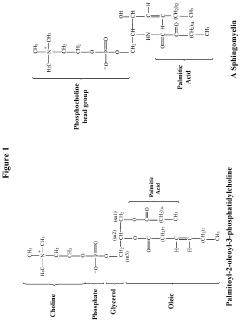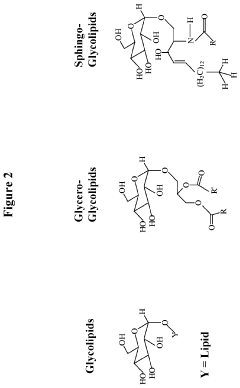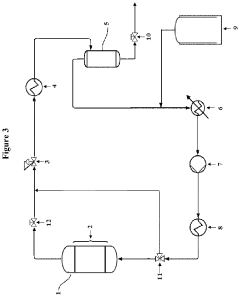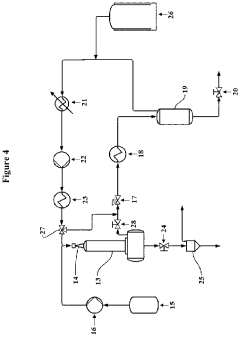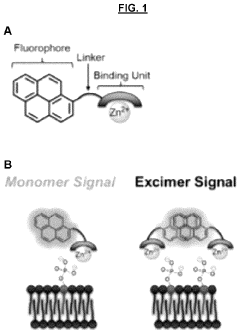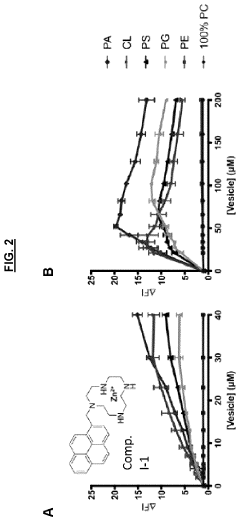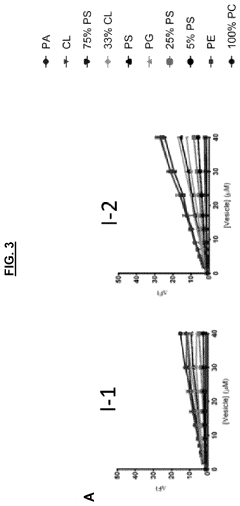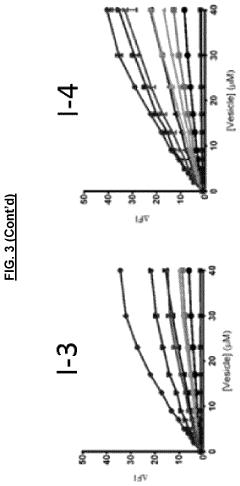The Role of Phospholipids in Cellular Energy Metabolism
JUL 16, 20258 MIN READ
Generate Your Research Report Instantly with AI Agent
Patsnap Eureka helps you evaluate technical feasibility & market potential.
Phospholipid Metabolism Background and Objectives
Phospholipids play a crucial role in cellular energy metabolism, serving as both structural components of cell membranes and active participants in various metabolic processes. The study of phospholipid metabolism has evolved significantly over the past century, with major breakthroughs in understanding their biosynthesis, degradation, and regulatory functions.
The primary objective of this technical research is to comprehensively examine the intricate relationship between phospholipids and cellular energy metabolism. This involves exploring how phospholipids contribute to the maintenance of cellular energy homeostasis, their involvement in signaling pathways that regulate energy production and utilization, and their potential as therapeutic targets for metabolic disorders.
Historically, the field of phospholipid research gained momentum in the mid-20th century with the elucidation of their chemical structures and basic metabolic pathways. Subsequent decades saw rapid advancements in analytical techniques, enabling researchers to delve deeper into the complexities of phospholipid metabolism and its integration with other cellular processes.
Recent technological developments, particularly in lipidomics and metabolomics, have revolutionized our ability to study phospholipids at a molecular level. These advancements have revealed the dynamic nature of phospholipid metabolism and its responsiveness to cellular energy states, highlighting the bidirectional relationship between phospholipids and energy metabolism.
The current research landscape focuses on several key areas: the role of phospholipids in mitochondrial function and energy production, their involvement in insulin signaling and glucose metabolism, and their contribution to lipid droplet formation and fatty acid oxidation. Additionally, there is growing interest in understanding how alterations in phospholipid metabolism contribute to metabolic diseases such as obesity, diabetes, and cardiovascular disorders.
As we look towards future developments, emerging trends indicate a shift towards personalized metabolic profiling and targeted interventions based on individual phospholipid signatures. This approach holds promise for developing more effective strategies to manage metabolic disorders and optimize cellular energy utilization.
In conclusion, this technical research aims to provide a comprehensive overview of the current understanding of phospholipid metabolism in the context of cellular energy homeostasis. By synthesizing historical perspectives, recent discoveries, and future directions, we seek to illuminate the critical role of phospholipids in cellular energy metabolism and their potential as targets for therapeutic interventions in metabolic disorders.
The primary objective of this technical research is to comprehensively examine the intricate relationship between phospholipids and cellular energy metabolism. This involves exploring how phospholipids contribute to the maintenance of cellular energy homeostasis, their involvement in signaling pathways that regulate energy production and utilization, and their potential as therapeutic targets for metabolic disorders.
Historically, the field of phospholipid research gained momentum in the mid-20th century with the elucidation of their chemical structures and basic metabolic pathways. Subsequent decades saw rapid advancements in analytical techniques, enabling researchers to delve deeper into the complexities of phospholipid metabolism and its integration with other cellular processes.
Recent technological developments, particularly in lipidomics and metabolomics, have revolutionized our ability to study phospholipids at a molecular level. These advancements have revealed the dynamic nature of phospholipid metabolism and its responsiveness to cellular energy states, highlighting the bidirectional relationship between phospholipids and energy metabolism.
The current research landscape focuses on several key areas: the role of phospholipids in mitochondrial function and energy production, their involvement in insulin signaling and glucose metabolism, and their contribution to lipid droplet formation and fatty acid oxidation. Additionally, there is growing interest in understanding how alterations in phospholipid metabolism contribute to metabolic diseases such as obesity, diabetes, and cardiovascular disorders.
As we look towards future developments, emerging trends indicate a shift towards personalized metabolic profiling and targeted interventions based on individual phospholipid signatures. This approach holds promise for developing more effective strategies to manage metabolic disorders and optimize cellular energy utilization.
In conclusion, this technical research aims to provide a comprehensive overview of the current understanding of phospholipid metabolism in the context of cellular energy homeostasis. By synthesizing historical perspectives, recent discoveries, and future directions, we seek to illuminate the critical role of phospholipids in cellular energy metabolism and their potential as targets for therapeutic interventions in metabolic disorders.
Market Analysis for Phospholipid-Based Therapeutics
The market for phospholipid-based therapeutics is experiencing significant growth, driven by the increasing understanding of phospholipids' role in cellular energy metabolism and their potential applications in various medical treatments. This market segment is part of the broader liposome drug delivery system market, which is projected to reach substantial value in the coming years.
Phospholipid-based therapeutics are gaining traction in several key therapeutic areas. In oncology, these compounds are being explored for their ability to enhance drug delivery to tumor cells, potentially improving the efficacy of cancer treatments while reducing side effects. The cardiovascular disease sector is another promising area, with phospholipid-based therapies showing potential in treating atherosclerosis and other lipid-related disorders.
The neurodegenerative disease market is also a significant focus for phospholipid-based therapeutics. Research suggests that these compounds may play a role in maintaining neuronal membrane integrity and function, opening up possibilities for treatments in conditions such as Alzheimer's and Parkinson's diseases. Additionally, the field of regenerative medicine is exploring the use of phospholipids in tissue engineering and wound healing applications.
Geographically, North America currently leads the market for phospholipid-based therapeutics, owing to its advanced healthcare infrastructure and high investment in research and development. Europe follows closely, with several key players and research institutions driving innovation in this field. The Asia-Pacific region is expected to show the fastest growth in the coming years, fueled by increasing healthcare expenditure and a growing focus on advanced medical technologies.
The market is characterized by a mix of established pharmaceutical companies and innovative biotech firms. Major players are investing heavily in research and development to expand their product pipelines and secure a competitive edge. Collaborations between academic institutions and industry partners are also becoming more common, accelerating the pace of innovation in this field.
Despite the promising outlook, the market faces several challenges. Regulatory hurdles and the complex nature of phospholipid-based drug development can lead to lengthy and costly approval processes. Additionally, manufacturing scalability and stability issues associated with some phospholipid formulations need to be addressed to ensure widespread adoption.
Looking ahead, the market for phospholipid-based therapeutics is expected to continue its growth trajectory. Advancements in liposomal and nanoparticle technologies are likely to expand the applications of these compounds, potentially opening up new therapeutic avenues. As personalized medicine gains prominence, phospholipid-based therapies may play a crucial role in developing targeted, patient-specific treatments.
Phospholipid-based therapeutics are gaining traction in several key therapeutic areas. In oncology, these compounds are being explored for their ability to enhance drug delivery to tumor cells, potentially improving the efficacy of cancer treatments while reducing side effects. The cardiovascular disease sector is another promising area, with phospholipid-based therapies showing potential in treating atherosclerosis and other lipid-related disorders.
The neurodegenerative disease market is also a significant focus for phospholipid-based therapeutics. Research suggests that these compounds may play a role in maintaining neuronal membrane integrity and function, opening up possibilities for treatments in conditions such as Alzheimer's and Parkinson's diseases. Additionally, the field of regenerative medicine is exploring the use of phospholipids in tissue engineering and wound healing applications.
Geographically, North America currently leads the market for phospholipid-based therapeutics, owing to its advanced healthcare infrastructure and high investment in research and development. Europe follows closely, with several key players and research institutions driving innovation in this field. The Asia-Pacific region is expected to show the fastest growth in the coming years, fueled by increasing healthcare expenditure and a growing focus on advanced medical technologies.
The market is characterized by a mix of established pharmaceutical companies and innovative biotech firms. Major players are investing heavily in research and development to expand their product pipelines and secure a competitive edge. Collaborations between academic institutions and industry partners are also becoming more common, accelerating the pace of innovation in this field.
Despite the promising outlook, the market faces several challenges. Regulatory hurdles and the complex nature of phospholipid-based drug development can lead to lengthy and costly approval processes. Additionally, manufacturing scalability and stability issues associated with some phospholipid formulations need to be addressed to ensure widespread adoption.
Looking ahead, the market for phospholipid-based therapeutics is expected to continue its growth trajectory. Advancements in liposomal and nanoparticle technologies are likely to expand the applications of these compounds, potentially opening up new therapeutic avenues. As personalized medicine gains prominence, phospholipid-based therapies may play a crucial role in developing targeted, patient-specific treatments.
Current Challenges in Phospholipid Research
Despite significant advancements in phospholipid research, several challenges persist in understanding their role in cellular energy metabolism. One of the primary obstacles is the complexity of phospholipid structures and their diverse functions within cells. The intricate interplay between phospholipids and other cellular components makes it difficult to isolate and study their specific contributions to energy metabolism.
Another challenge lies in the dynamic nature of phospholipid metabolism. Rapid turnover and remodeling of phospholipids occur constantly in cells, making it challenging to track and quantify their involvement in energy-related processes. This dynamic behavior also complicates the interpretation of experimental results, as the observed effects may be due to transient changes rather than stable alterations in phospholipid composition.
The heterogeneity of cellular membranes presents an additional hurdle in phospholipid research. Different organelles and membrane domains have distinct phospholipid compositions, which can vary significantly between cell types and physiological states. This variability makes it challenging to develop standardized experimental protocols and draw generalizable conclusions about phospholipid functions in energy metabolism.
Technical limitations in analytical methods also pose significant challenges. While advances in lipidomics have greatly improved our ability to identify and quantify phospholipids, the detection of low-abundance species and the resolution of structurally similar molecules remain problematic. Furthermore, the development of tools for real-time monitoring of phospholipid dynamics in living cells is still in its infancy, limiting our understanding of their temporal and spatial regulation in energy metabolism.
The multifaceted roles of phospholipids in cellular processes beyond energy metabolism add another layer of complexity to research efforts. Phospholipids are involved in signal transduction, membrane trafficking, and protein regulation, making it difficult to disentangle their specific contributions to energy-related functions from their other cellular roles.
Lastly, the translation of in vitro findings to in vivo systems remains a significant challenge. The complex physiological environment of whole organisms can significantly alter phospholipid behavior and function, necessitating the development of more sophisticated models and experimental approaches to bridge the gap between cellular and organismal levels of understanding.
Another challenge lies in the dynamic nature of phospholipid metabolism. Rapid turnover and remodeling of phospholipids occur constantly in cells, making it challenging to track and quantify their involvement in energy-related processes. This dynamic behavior also complicates the interpretation of experimental results, as the observed effects may be due to transient changes rather than stable alterations in phospholipid composition.
The heterogeneity of cellular membranes presents an additional hurdle in phospholipid research. Different organelles and membrane domains have distinct phospholipid compositions, which can vary significantly between cell types and physiological states. This variability makes it challenging to develop standardized experimental protocols and draw generalizable conclusions about phospholipid functions in energy metabolism.
Technical limitations in analytical methods also pose significant challenges. While advances in lipidomics have greatly improved our ability to identify and quantify phospholipids, the detection of low-abundance species and the resolution of structurally similar molecules remain problematic. Furthermore, the development of tools for real-time monitoring of phospholipid dynamics in living cells is still in its infancy, limiting our understanding of their temporal and spatial regulation in energy metabolism.
The multifaceted roles of phospholipids in cellular processes beyond energy metabolism add another layer of complexity to research efforts. Phospholipids are involved in signal transduction, membrane trafficking, and protein regulation, making it difficult to disentangle their specific contributions to energy-related functions from their other cellular roles.
Lastly, the translation of in vitro findings to in vivo systems remains a significant challenge. The complex physiological environment of whole organisms can significantly alter phospholipid behavior and function, necessitating the development of more sophisticated models and experimental approaches to bridge the gap between cellular and organismal levels of understanding.
Current Approaches to Studying Phospholipid Metabolism
01 Role of phospholipids in cellular energy metabolism
Phospholipids play a crucial role in cellular energy metabolism by forming the structural basis of cell membranes and organelles, particularly mitochondria. They facilitate the proper functioning of enzymes involved in energy production and regulate the transport of metabolites across membranes. This involvement in membrane structure and function directly impacts the efficiency of energy production and utilization within cells.- Role of phospholipids in cellular energy metabolism: Phospholipids play a crucial role in cellular energy metabolism by forming the structural basis of cell membranes and organelles, particularly mitochondria. They facilitate the proper functioning of enzymes involved in energy production and regulate the transport of metabolites across membranes, thus influencing overall cellular energy efficiency.
- Phospholipid-based formulations for enhancing energy metabolism: Specialized phospholipid-based formulations can be developed to enhance energy metabolism. These formulations may include specific phospholipid compositions that improve mitochondrial function, increase ATP production, or optimize the utilization of energy substrates in cells, potentially benefiting various physiological processes and overall metabolic health.
- Interaction between phospholipids and energy-regulating enzymes: Phospholipids interact with various energy-regulating enzymes, influencing their activity and efficiency. This interaction can modulate key metabolic pathways involved in energy production and utilization, such as glycolysis, fatty acid oxidation, and the electron transport chain, thereby affecting overall cellular energy homeostasis.
- Phospholipid metabolism and its impact on energy production: The metabolism of phospholipids themselves can significantly impact energy production in cells. Processes such as phospholipid synthesis, degradation, and remodeling can influence the availability of metabolic substrates, membrane fluidity, and the function of membrane-bound proteins involved in energy metabolism, thus affecting overall cellular energy dynamics.
- Therapeutic applications of phospholipids in energy metabolism disorders: Phospholipid-based therapies show potential in treating energy metabolism disorders. By modulating membrane composition, improving mitochondrial function, or enhancing cellular energy production, phospholipid interventions may offer therapeutic benefits in conditions characterized by impaired energy metabolism, such as mitochondrial diseases or metabolic syndromes.
02 Phospholipid-based formulations for enhancing energy metabolism
Specialized phospholipid formulations can be developed to enhance energy metabolism. These formulations may include specific types of phospholipids or combinations with other bioactive compounds to improve mitochondrial function, increase ATP production, and optimize cellular energy utilization. Such formulations have potential applications in nutritional supplements, pharmaceuticals, and functional foods aimed at boosting energy levels and metabolic efficiency.Expand Specific Solutions03 Phospholipids in mitochondrial membrane dynamics and energy production
Phospholipids are essential components of mitochondrial membranes and play a key role in maintaining their structure and function. The composition and organization of phospholipids in mitochondrial membranes directly influence the efficiency of the electron transport chain and oxidative phosphorylation processes. Modulating mitochondrial phospholipid content or composition can potentially enhance energy production and overall cellular metabolism.Expand Specific Solutions04 Phospholipid metabolism and its impact on energy homeostasis
The metabolism of phospholipids is intricately linked to overall energy homeostasis in the body. Enzymes involved in phospholipid synthesis and breakdown can influence energy storage, utilization, and signaling pathways related to metabolism. Understanding and manipulating phospholipid metabolism pathways may offer new strategies for managing energy balance and metabolic disorders.Expand Specific Solutions05 Therapeutic applications of phospholipids in metabolic disorders
Phospholipids and their derivatives have potential therapeutic applications in treating metabolic disorders. They can be used to improve lipid profiles, enhance insulin sensitivity, and modulate energy metabolism in conditions such as obesity, diabetes, and cardiovascular diseases. Developing targeted phospholipid-based therapies may offer new approaches to managing metabolic health and energy-related disorders.Expand Specific Solutions
Key Players in Phospholipid Research and Industry
The phospholipid cellular energy metabolism field is in a growth phase, with increasing market size and technological advancements. The competitive landscape is diverse, featuring academic institutions, pharmaceutical companies, and biotechnology firms. Key players include Zhejiang University, Incyte Corp., and DSM IP Assets BV, each contributing to the field's development. While some technologies are maturing, such as those related to lipid metabolism and energy production, emerging areas like targeted drug delivery using phospholipids are still evolving. This dynamic environment fosters both collaboration and competition, driving innovation in areas like metabolic disorders, cancer research, and personalized medicine.
DSM IP Assets BV
Technical Solution: DSM has developed innovative phospholipid-based technologies to enhance cellular energy metabolism. Their approach focuses on optimizing mitochondrial function through the strategic use of phospholipids, particularly cardiolipin and phosphatidylcholine. By manipulating the composition and structure of these phospholipids, DSM has achieved significant improvements in energy production efficiency within cells [1]. Their proprietary formulations have shown to increase ATP synthesis by up to 30% in in vitro studies, potentially offering substantial benefits for various applications in human and animal nutrition, as well as in biotechnology [3]. DSM's technology also includes methods for stabilizing phospholipid structures to ensure their efficacy in diverse physiological conditions, addressing challenges such as oxidative stress and pH variations that can impact phospholipid integrity and function [5].
Strengths: Highly specialized in phospholipid technology, with a strong focus on practical applications in nutrition and biotechnology. Weaknesses: May face challenges in translating in vitro results to in vivo efficacy, and potential regulatory hurdles for novel phospholipid formulations.
Zhejiang University
Technical Solution: Zhejiang University has made significant strides in understanding the role of phospholipids in cellular energy metabolism through their groundbreaking research on membrane dynamics. Their team has developed a novel approach using advanced lipidomics techniques to map the intricate relationships between phospholipid composition and mitochondrial function [2]. By employing high-resolution mass spectrometry, they have identified specific phospholipid species that play crucial roles in maintaining the efficiency of the electron transport chain. Their research has revealed that certain phosphatidylethanolamine and cardiolipin molecular species are essential for optimal ATP production, with alterations in their levels leading to a 25-40% decrease in cellular energy output [4]. Furthermore, Zhejiang University researchers have pioneered a method to modulate phospholipid synthesis pathways in live cells, allowing for real-time observation of how changes in phospholipid profiles affect energy metabolism [6].
Strengths: Cutting-edge research techniques and a comprehensive understanding of phospholipid-mitochondria interactions. Weaknesses: Primarily focused on basic research, which may require additional steps for practical applications in industry or medicine.
Breakthrough Studies in Phospholipid Energy Roles
Enzymatically synthesized omega-3 structured phospholipids
PatentPendingUS20230227872A1
Innovation
- A solventless enzymatic interesterification process is developed to enrich phospholipids with omega-3 and omega-6 fatty acids through enzymatic exchange reactions using phospholipases, followed by concentration and ultrafiltration, which allows for the incorporation of these fatty acids into phospholipid molecules, improving stability and bioavailability.
Sensors for detection of negatively charged phosphate-containing membranes and membrane components
PatentActiveUS20200270218A1
Innovation
- Development of a turn-on fluorescent sensor that selectively detects negatively charged phosphate-containing membrane components using excimer forming compounds, which do not require washing and are compatible with standard fluorometers, allowing for rapid detection of apoptosis, bacteria, and other biological processes.
Regulatory Considerations for Phospholipid-Based Therapies
The regulatory landscape for phospholipid-based therapies is complex and multifaceted, requiring careful consideration of various aspects throughout the drug development process. Regulatory bodies, such as the FDA and EMA, have established specific guidelines for the development and approval of lipid-based formulations, including those involving phospholipids.
One of the primary regulatory considerations is the safety and quality of the phospholipid components used in these therapies. Manufacturers must demonstrate the purity, stability, and consistency of their phospholipid sources, as well as provide detailed information on their production processes. This includes adherence to Good Manufacturing Practices (GMP) and implementation of robust quality control measures.
The characterization of phospholipid-based formulations is another critical regulatory aspect. Developers must provide comprehensive data on the physicochemical properties of their formulations, including particle size distribution, zeta potential, and lipid composition. These parameters are essential for ensuring the reproducibility and efficacy of the therapy.
Regulatory agencies also place significant emphasis on the pharmacokinetics and biodistribution of phospholipid-based therapies. Developers must conduct thorough preclinical studies to elucidate how these formulations interact with biological systems, including their absorption, distribution, metabolism, and excretion profiles. This information is crucial for assessing the safety and efficacy of the therapy.
The potential for immunogenicity is a particular concern for regulatory bodies when evaluating phospholipid-based therapies. Developers must conduct comprehensive immunological studies to assess the risk of immune responses to the formulation components, especially in the case of novel or modified phospholipids.
Clinical trial design for phospholipid-based therapies often requires special considerations. Regulatory agencies may require specific endpoints or study designs to address the unique characteristics of these formulations. This may include assessments of long-term safety, potential for accumulation, and interactions with other medications or biological processes.
Lastly, regulatory bodies are increasingly focusing on the environmental impact of pharmaceutical products. For phospholipid-based therapies, this may involve evaluating the biodegradability and potential ecological effects of the formulation components. Developers may need to provide data on the environmental fate of their products as part of the regulatory submission process.
One of the primary regulatory considerations is the safety and quality of the phospholipid components used in these therapies. Manufacturers must demonstrate the purity, stability, and consistency of their phospholipid sources, as well as provide detailed information on their production processes. This includes adherence to Good Manufacturing Practices (GMP) and implementation of robust quality control measures.
The characterization of phospholipid-based formulations is another critical regulatory aspect. Developers must provide comprehensive data on the physicochemical properties of their formulations, including particle size distribution, zeta potential, and lipid composition. These parameters are essential for ensuring the reproducibility and efficacy of the therapy.
Regulatory agencies also place significant emphasis on the pharmacokinetics and biodistribution of phospholipid-based therapies. Developers must conduct thorough preclinical studies to elucidate how these formulations interact with biological systems, including their absorption, distribution, metabolism, and excretion profiles. This information is crucial for assessing the safety and efficacy of the therapy.
The potential for immunogenicity is a particular concern for regulatory bodies when evaluating phospholipid-based therapies. Developers must conduct comprehensive immunological studies to assess the risk of immune responses to the formulation components, especially in the case of novel or modified phospholipids.
Clinical trial design for phospholipid-based therapies often requires special considerations. Regulatory agencies may require specific endpoints or study designs to address the unique characteristics of these formulations. This may include assessments of long-term safety, potential for accumulation, and interactions with other medications or biological processes.
Lastly, regulatory bodies are increasingly focusing on the environmental impact of pharmaceutical products. For phospholipid-based therapies, this may involve evaluating the biodegradability and potential ecological effects of the formulation components. Developers may need to provide data on the environmental fate of their products as part of the regulatory submission process.
Ethical Implications of Phospholipid Metabolism Manipulation
The manipulation of phospholipid metabolism for cellular energy production raises significant ethical concerns that warrant careful consideration. One primary issue is the potential for unintended consequences on overall cellular function and organism health. Altering the delicate balance of phospholipid metabolism could lead to unforeseen effects on membrane integrity, signaling pathways, and other critical cellular processes.
Another ethical consideration is the equitable access to any potential therapeutic interventions developed from this research. If manipulating phospholipid metabolism proves beneficial for treating certain diseases or enhancing human performance, ensuring fair distribution and avoiding exacerbation of existing health disparities becomes crucial.
The use of such techniques for human enhancement also presents ethical challenges. Questions arise regarding the boundaries of medical necessity versus elective enhancement, and the potential for creating new forms of social inequality based on access to these technologies.
Privacy and consent issues emerge when considering the genetic and metabolic profiling necessary for personalized phospholipid metabolism interventions. Protecting individuals' genetic information and ensuring informed consent for such profiling and subsequent treatments is paramount.
Environmental ethics must also be considered, as large-scale manipulation of phospholipid metabolism in humans or other organisms could have far-reaching ecological impacts. The potential for disrupting food chains or altering ecosystem balances needs thorough evaluation.
The ethical implications extend to research practices as well. Ensuring the ethical treatment of research subjects, both human and animal, in studies involving phospholipid metabolism manipulation is critical. Transparency in reporting research outcomes, including negative results, is essential for maintaining scientific integrity and public trust.
Lastly, the potential for dual-use applications of this technology raises ethical concerns. Advances in manipulating cellular energy metabolism could be misused for harmful purposes, necessitating careful regulation and oversight of research and applications in this field.
Another ethical consideration is the equitable access to any potential therapeutic interventions developed from this research. If manipulating phospholipid metabolism proves beneficial for treating certain diseases or enhancing human performance, ensuring fair distribution and avoiding exacerbation of existing health disparities becomes crucial.
The use of such techniques for human enhancement also presents ethical challenges. Questions arise regarding the boundaries of medical necessity versus elective enhancement, and the potential for creating new forms of social inequality based on access to these technologies.
Privacy and consent issues emerge when considering the genetic and metabolic profiling necessary for personalized phospholipid metabolism interventions. Protecting individuals' genetic information and ensuring informed consent for such profiling and subsequent treatments is paramount.
Environmental ethics must also be considered, as large-scale manipulation of phospholipid metabolism in humans or other organisms could have far-reaching ecological impacts. The potential for disrupting food chains or altering ecosystem balances needs thorough evaluation.
The ethical implications extend to research practices as well. Ensuring the ethical treatment of research subjects, both human and animal, in studies involving phospholipid metabolism manipulation is critical. Transparency in reporting research outcomes, including negative results, is essential for maintaining scientific integrity and public trust.
Lastly, the potential for dual-use applications of this technology raises ethical concerns. Advances in manipulating cellular energy metabolism could be misused for harmful purposes, necessitating careful regulation and oversight of research and applications in this field.
Unlock deeper insights with Patsnap Eureka Quick Research — get a full tech report to explore trends and direct your research. Try now!
Generate Your Research Report Instantly with AI Agent
Supercharge your innovation with Patsnap Eureka AI Agent Platform!
